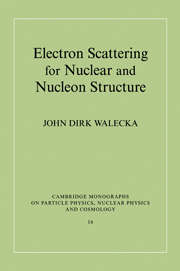Book contents
- Frontmatter
- Contents
- Preface
- Part 1 Introduction
- 1 Motivation
- 2 Pictures of the nucleus
- 3 Some optics
- 4 Why electron scattering?
- 5 Target response surfaces
- 6 Why coincidence experiments?
- 7 Units and conventions
- Part 2 General analysis
- Part 3 Quantum electrodynamics
- Part 4 Selected examples
- Part 5 Future directions
- Appendixes
- References
- Index
1 - Motivation
from Part 1 - Introduction
- Frontmatter
- Contents
- Preface
- Part 1 Introduction
- 1 Motivation
- 2 Pictures of the nucleus
- 3 Some optics
- 4 Why electron scattering?
- 5 Target response surfaces
- 6 Why coincidence experiments?
- 7 Units and conventions
- Part 2 General analysis
- Part 3 Quantum electrodynamics
- Part 4 Selected examples
- Part 5 Future directions
- Appendixes
- References
- Index
Summary
This monograph is concerned with the study of nuclear and nucleon structure through the scattering of high energy electrons. The history of this field is well summarized in the proceedings of the Conference on 35 Years of Electron Scattering held at the University of Illinois in 1986 to commemorate the 1951 experiment of Lyman, Hanson, and Scott; this experiment provided the first observation of the finite size of the nucleus by electron scattering [Ly51, Il87]. Hofstadter and his colleagues, working in the High Energy Physics Laboratory (HEPL) at Stanford University in the late 1950's, beautifully and systematically exhibited the shape of the charge distributions of nuclei and nucleons through experiments at higher momentum transfer [Ho56, Ho63]. Subsequent experimental work at HEPL, the Bates Laboratory at M.I.T., Saclay in France, NIKHEF in Holland, and both Darmstadt and Mainz in Germany (as well as other laboratories), utilizing parallel theoretical analysis [Gu34, Sc54, Al56, de66, Ub71], clearly exhibited more detailed aspects of nuclear structure. Experiments at higher electron energies and momentum transfers at the Stanford Linear Accelerator Center (SLAC) by Friedman, Kendall, and Taylor, together with theoretical developments by Bjorken, for the first time demonstrated the pointlike quark–parton substructure of nucleons and nuclei [Bj69, Fr72]. This work played a key role in the development of modern theories of the strong interaction. Major efforts today at CEBAF, the Continuous Electron Beam Accelerator Facility (now known as TJNAF, the Thomas Jefferson National Accelerator Facility) in the U.S., Bates, Mainz, SLAC, DESY in Germany, and CERN in Geneva (using muons) contribute to the development of our understanding of nuclei and nucleons.
- Type
- Chapter
- Information
- Publisher: Cambridge University PressPrint publication year: 2001



